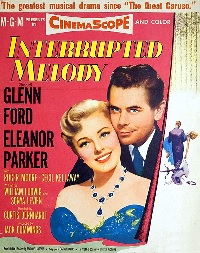
Interrupted Melody is a 1955 American musical biopic film starring Eleanor Parker, Glenn Ford, Roger Moore, and Cecil Kellaway. Directed by Curtis Bernhardt, it was filmed in CinemaScope and Eastman Color, and produced for Metro-Goldwyn-Mayer by Jack Cummings. With a screenplay by Lawrence, Sonya Levien, and William Ludwig, the operatic sequences were staged by Vladimir Rosing, and Eileen Farrell provided the singing voice for Parker. It tells the story of Australian soprano Marjorie Lawrence's rise to fame as an opera singer and her subsequent triumph over polio with her husband's help
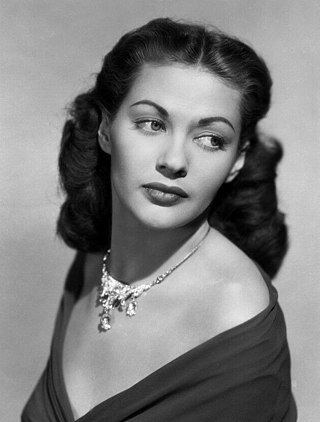
Margaret Yvonne Middleton, known professionally as Yvonne De Carlo, was a Canadian-American actress, dancer and singer. She became a Hollywood film star in the 1940s and 1950s, made several recordings, and later acted on television and stage.

Forrest Meredith Tucker was an American actor in both movies and television who appeared in nearly a hundred films. Tucker worked as a vaudeville straight man at the age of fifteen. A mentor provided funds and contacts for a trip to California, where party hostess Cobina Wright persuaded guest Wesley Ruggles to give Tucker a screen test because of Tucker's photogenic good looks, thick wavy hair and height of six feet, five inches.

Robert Cletus Driscoll was an American actor who performed on film and television from 1943 to 1960. He starred in some of the Walt Disney Studios' best-known live-action pictures of that period: Song of the South (1946), So Dear to My Heart (1949), and Treasure Island (1950), as well as RKO's The Window (1949). He served as the animation model and provided the voice for the title role in Peter Pan (1953). He received an Academy Juvenile Award for outstanding performances in So Dear to My Heart and The Window.

Harold Thomas Gregson, known professionally as John Gregson, was an English actor of stage, television and film, with 40 credited film roles. He was best known for his crime drama and comedy roles.

Charles John "Tim" Holt III was an American actor. He was a popular Western star during the 1940s and early 1950s, appearing in forty-six B westerns released by RKO Pictures.
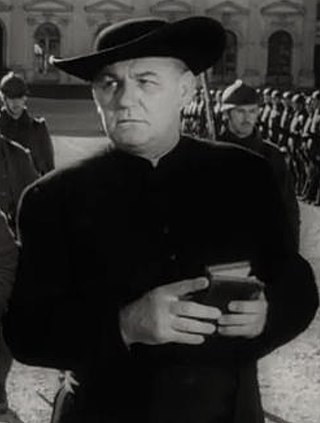
Emile Meyer was an American actor, usually known for tough, aggressive, authoritative characters in Hollywood films from the 1950s era, mostly in Westerns or thrillers.

Against All Flags is a 1952 American pirate film directed by George Sherman, with uncredited assist from Douglas Sirk. It features Errol Flynn as Lt. Brian Hawke, Maureen O'Hara as Prudence "Spitfire" Stevens, and Anthony Quinn as Roc Brasiliano. The film is set in 1700, on the coast of Madagascar.

All the Brothers Were Valiant is a 1953 Technicolor adventure drama film produced by Metro-Goldwyn-Mayer and directed by Richard Thorpe. The film's screenplay was written by Harry Brown and based on the 1919 novel All the Brothers Were Valiant by Ben Ames Williams. The music score was led by Miklós Rózsa and the cinematography by George J. Folsey.
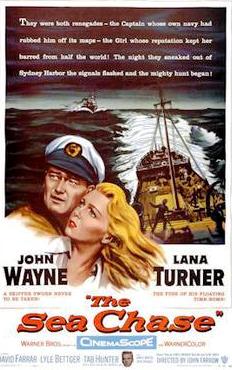
The Sea Chase is a 1955 World War II drama film starring John Wayne and Lana Turner, and featuring David Farrar, Lyle Bettger, and Tab Hunter. It was directed by John Farrow from a screenplay by James Warner Bellah and John Twist based on the novel of the same name by Andrew Geer. The plot is a nautical cat and mouse adventure, with Wayne determined to get his freighter home to Germany during the opening months of World War II, chased relentlessly across the Pacific then Atlantic oceans by the Australian and then British navies.
Pine-Thomas Productions was a prolific B-picture unit of Paramount Pictures from 1940–1957, producing 81 films. Co-producers William H. Pine and William C. Thomas were known as the "Dollar Bills" because none of their economically made films ever lost money. "We don't want to make million dollar pictures," they said. "We just want to make a million dollars."
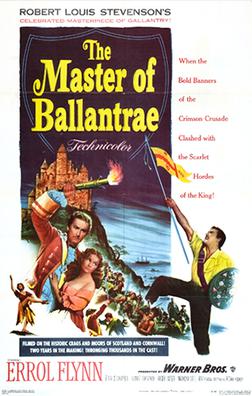
The Master of Ballantrae is a 1953 British Technicolor adventure film starring Errol Flynn and Roger Livesey. It is a loose and highly truncated adaptation of the Robert Louis Stevenson 1889 novel of the same name. In eighteenth century Scotland, two sons of a laird clash over the family estate and a lady. It was the last film directed by William Keighley.
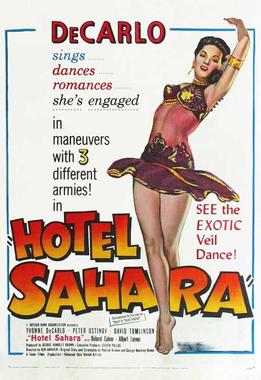
Hotel Sahara is a 1951 British war comedy film directed by Ken Annakin and starring Yvonne De Carlo, Peter Ustinov and David Tomlinson. It was produced and co-written by George Hambley Brown.
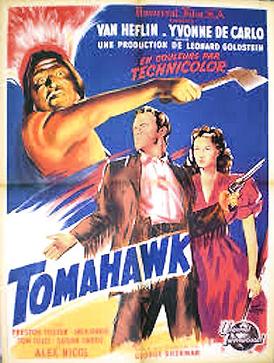
Tomahawk is a 1951 American Western film directed by George Sherman and starring Van Heflin and Yvonne De Carlo. The film is loosely based on events that took place in Wyoming in 1866 to 1868 around Fort Phil Kearny on the Bozeman Trail such as the Fetterman Fight and Wagon Box Fight. In the UK, the film was released as The Battle of Powder River.
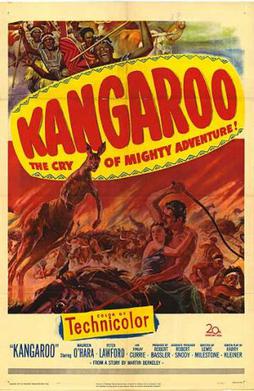
Kangaroo is a 1952 American Western film directed by Lewis Milestone. It was the first Technicolor film filmed on location in Australia. Milestone called it "an underrated picture."

Silver City is a 1951 American Western film directed by Byron Haskin and starring Edmond O'Brien, Yvonne De Carlo, and Barry Fitzgerald.
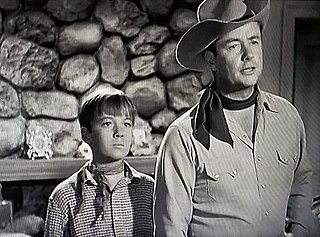
Gunplay is a 1951 American western film directed by Lesley Selander. It stars Tim Holt and Joan Dixon. It reunited Holt and Dixon from Law of the Badlands. The film was originally called Gun Notches. Filming took place in late 1950.

The Vanquished is a 1953 American Western film directed by Edward Ludwig, written by Lewis R. Foster, Winston Miller and Frank L. Moss, and starring John Payne, Jan Sterling, Coleen Gray, Lyle Bettger, Willard Parker, Roy Gordon and John Dierkes. It was released on June 3, 1953, by Paramount Pictures.

Hurricane Island is a 1951 American Supercinecolor adventure film directed by Lew Landers and starring Jon Hall.


















